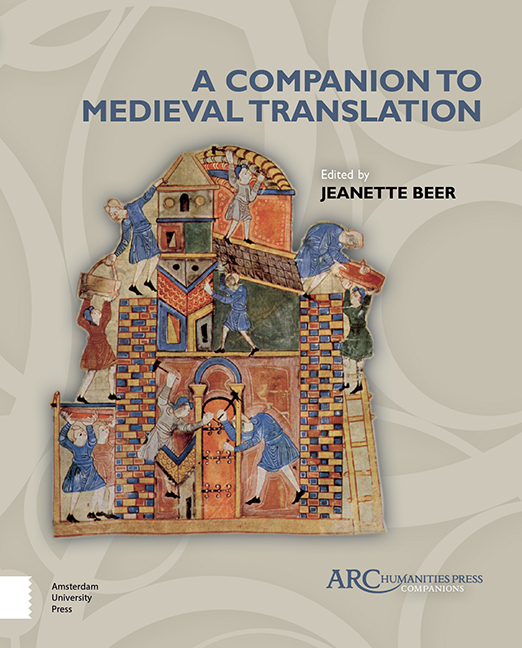Book contents
- Frontmatter
- Contents
- Acknowledgements
- Introduction
- Chapter 1 The European Psalms in Translation
- Chapter 2 The Old French Bible
- Chapter 3 Middle English Religious Translation
- Chapter 4 Bible Translation and Controversy in Late Medieval England
- Chapter 5 Medieval Convent Drama: Translating Scripture and Transforming the Liturgy
- Chapter 6 Translating Romance in Medieval Norway: Marie de France and Strengleikar
- Chapter 7 Christine de Pizan, Translator and Translation Critic
- Chapter 8 Translation, Authority, and the Valorization of the Vernacular
- Chapter 9 Vernacular Translation in Medieval Italy: volgarizzamento
- Chapter 10 Dante and Translation
- Chapter 11 Chaucer and Translation
- Chapter 12 Alchemy and Translation
- Chapter 13 Scientific Translation: A Modern Editor’s Perspectiv
- Chapter 14 Modern Theoretical Approaches to Medieval Translation
- Chapter 15 Observations on Translation by a Thirteenth-Century Maître: Li Fet des Romains
- Epilogue. Observations on Translation by the Oxford Professor of Poetry: Pearl
- General Bibliography
- Appendix
- Index
Chapter 4 - Bible Translation and Controversy in Late Medieval England
Published online by Cambridge University Press: 20 November 2020
- Frontmatter
- Contents
- Acknowledgements
- Introduction
- Chapter 1 The European Psalms in Translation
- Chapter 2 The Old French Bible
- Chapter 3 Middle English Religious Translation
- Chapter 4 Bible Translation and Controversy in Late Medieval England
- Chapter 5 Medieval Convent Drama: Translating Scripture and Transforming the Liturgy
- Chapter 6 Translating Romance in Medieval Norway: Marie de France and Strengleikar
- Chapter 7 Christine de Pizan, Translator and Translation Critic
- Chapter 8 Translation, Authority, and the Valorization of the Vernacular
- Chapter 9 Vernacular Translation in Medieval Italy: volgarizzamento
- Chapter 10 Dante and Translation
- Chapter 11 Chaucer and Translation
- Chapter 12 Alchemy and Translation
- Chapter 13 Scientific Translation: A Modern Editor’s Perspectiv
- Chapter 14 Modern Theoretical Approaches to Medieval Translation
- Chapter 15 Observations on Translation by a Thirteenth-Century Maître: Li Fet des Romains
- Epilogue. Observations on Translation by the Oxford Professor of Poetry: Pearl
- General Bibliography
- Appendix
- Index
Summary
The Two Versions of the Middle English Bible
It was not until the latter part of the fourteenth century that the whole Bible was translated into English, first in a very literal form (the Early Version), which was then revised into more fluent prose (the Later Version). Following the lead of the editors of the 1850 edition, Josiah Forshall and Frederic Madden, the combined result is sometimes referred to as the “Wyclif(fe) Bible,” or the “Lollard Bible,” or, most frequently, the “Wycliffite Bible.” Sometimes, however, it goes by the neutral designation of “Middle English Bible,” which I follow, since I do not think that the case for Wycliffite content, origin, or reception has been made. Not a single word or phrase in either version has been identified as having heterodox import. Furthermore, although both Wyclif and two of his followers, Nicholas Hereford and John Purvey, used to be confidently considered to be among the translators, that is no longer the case. Finally, the texts were widely copied and used in impeccably orthodox circumstances, and, contrary to frequent assertions, neither version was prohibited by the Canterbury constitutions formulated at Oxford in 1407. These matters will be discussed below.
The Earlier Version of the Middle English Bible seems have been done at Oxford in the 1370s or so, with the Later Version revision probably occurring sometime in the 1380s. Both forms, but especially the Later Version, became very popular, surviving in many manuscripts. A number of theories have been put forth as to why the work of translation was done in stages. One is that the Early Version was originally designed to help the parish clergy that came to Oxford for a few years of study, in order to increase their understanding of the Latin Bible. Another is that it was done to ensure that the exact meaning of the Latin Scripture was being transferred into English before it was modified into less awkward idioms. Sven Fristedt has suggested that the revision was due to a change in translation philosophy, from grammatical and literal fidelity to a more elastic conception of meaning.
- Type
- Chapter
- Information
- Companion to Medieval Translation , pp. 51 - 62Publisher: Amsterdam University PressPrint publication year: 2019

